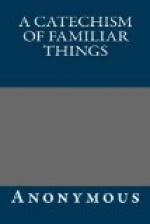What progress did the Romans make in Sculpture?
Sculpture, during their early history, existed rather as a plant of foreign growth, partially cultivated by them, than as a native production of their own land. They collected, indeed, some of the most exquisite samples of Grecian sculpture, and invited to their capital the yet remaining sculptors of Greece, by whose labors not only Rome itself was embellished, but also many of the cities of Asia Minor, Spain, and Gaul, then under the Roman dominion; yet the taste for sculpture does not appear to have been cultivated in any measure corresponding with the advantages thus afforded them in the study of the best models of the art. The best works were produced by Greek artists, and chiefly Athenian, while the attempts of the Romans were unskilfully executed.
Gaul, the ancient name of France.
Model, pattern.
Did it always continue thus?
No; from the time of the Emperor Constantine, sculpture, and the rest of the fine arts, gradually revived. While inspired, perhaps, with a taste for sculpture by means of the scattered remains of Grecian art, the Roman artists drew, at the same time, from their own resources, and were by no means servile copyists of the sculptors of a former age. The first academy of the art was founded at Florence, in 1350, and at the close of the same century, sculpture was firmly established in Italy, and itinerant sculptors, not unskilful in their art, wandered from thence to Germany, France, and even to England. The most eminent master of the art was Michael Angelo, born in 1474, who was also a painter and architect; from his time, to the latter end of the last century, sculpture again gradually declined, but under Canova, a native of Possagno, in the Venetian Alps, it revived. He was born in 1757. Besides the above mentioned, were a number of others of various degrees of talent, as well as some still living.
Servile, slavish, mean.
Itinerant, wandering.
When was the knowledge of Sculpture introduced into England?
At the time of its conquest by the Romans; but the art appears to have been very rude and imperfect. From the time of the Norman invasion, and still further in the time of the Crusades, an improvement, however, began to show itself in British sculpture. But it is probable that most of their best architectural and sculptural works were executed by foreigners, members of those societies of wandering sculptors before mentioned. Under Edward the Third, the art appears to have been much cultivated by Englishmen. It is well known that two Italian sculptors were employed in England during the sixteenth century. John of Padua, a pupil of Michael Angelo, was master of works to Henry the Eighth. In the reign of Charles the First, English sculptors flourished, although their works are of a very low order.
Invasion, hostile
entrance upon the rights or possessions
of another.




